#bonebed
Text




Back at the Lambeosaurus (Liberty) quarry! I've been using a ZOIC T-Rex and modified Chicago Pneumatic CP-9361 to trench around bones so they're able to be jacketed and collected.
#Badlands Dinosaur Museum#judith river formation#Jack's bonebed#Liberty#havre#dinosaurs#Lambeosaurus#hadrosaur#palaeontology#paleoblr#palaeoblr#fieldwork#paleontology#fieldwork 2024
97 notes
·
View notes
Note
You like fossil pokemon? That's really cool, I like fossil pokemon too, though I don't own any since there aren't really any in alola.
My name is Shock, btw. it's nice to meet you
- Shock ( @zap-the-raichu-hero )
Nice to meet you too! If you want to know why Alola has no fossils, it's because it's a series of relatively recent volcanic islands! Most of the fossils there are mundane birds! My personal favorite one of these mundane birds is Talpanas, a fully terrestrial type of duck that was most likely blind, and also most likely had a similar niche to the modern kiwi!
2 notes
·
View notes
Text
I dreamt I finally understood what ASMR was
Just like the entire body shaking uncontrollably like an earthquake
I asked later and boy that was a low-flying plane
0 notes
Note
Just saw ur vulture post. Could a dinosaur have a crown like a chicken? If so, which ones are most likely to have this feature?
I feel like chicken combs are one of those things that's so normal to us because we're familiar with chickens that we don't appreciate how wacky looking it is, like this animal's entire face gets turned into a massive billboard of red skin flaps.

As far as I'm aware there's no underlying bone structure that correlates to chickens' combs, so if an extinct dinosaur did have one we wouldn't see it in the fossil record unless it was exceptionally well preserved. That being said, there are a few guidelines that can help make some generally arm-wavey guesses about what may or may not have had them!
For predator species I'd say large brightly coloured billboards on the face are fairly unlikely since across most land vertebrates predators tend to prioritise stealth and blending in. I don't know for sure, but I would guess that more carrion-eating vultures have adornment because they don't need to stay hidden from their food, cause it's, y'know. dead.
Dromaeosaurs are generally though to be predators, although like most predators they probably incorporated scavenging into their feeding patterns and we don't know whether there were any species that specialised as carrion eaters! I have drawn dromaeosaurs with combs or crests before, and I definitely don't think it's an impossible suggestion, but I think it's most reasonable to give them muted colours like with this Saurornitholestes:
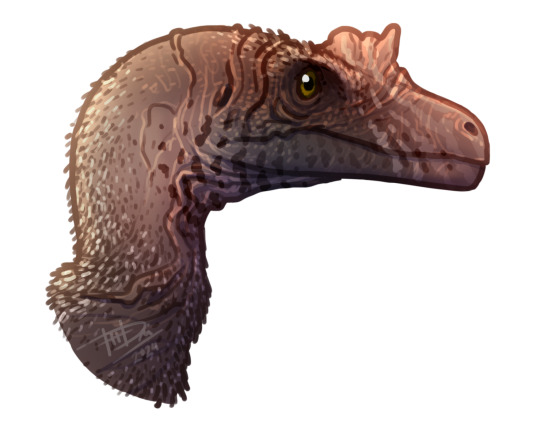
I would guess that smaller omnivorous or herbivorous maniraptorans like oviraptorosaurs or small ground birds are more likely candidates to have flashy skin on their faces, although large oviraptorosaurs with bony crests probably didn't also have a comb on top of that.
Something like Avimimus, which was a small oviraptorosaur that likely lived in groups according to a bonebed of at least ten individuals together. Something like a colourful comb or wattles on these guys could be used for social signalling or species recognition:

As far as I'm aware there's next to no skin data for small ornithischians like heterodontosaurids and ornithopods aside from the funky Kulindadromeus scales, but being small, mostly herbivorous, probably quite social animals I can see an evolutionary benefit to bright signalling structures! Alongside oviraptorosaurs, I think small ornithischians like Manidens here are probably the best non-avian analogue to modern ground fowl that have these kinda of wacky skin structures:
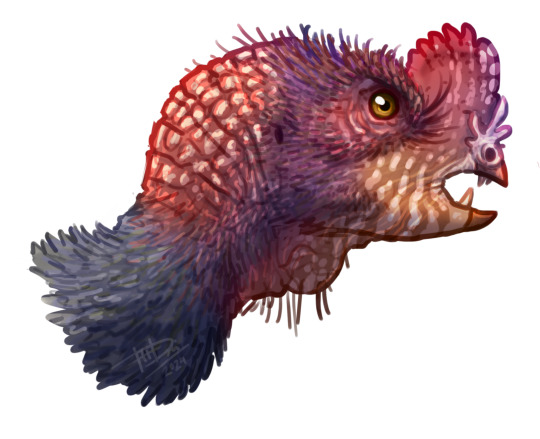
So overall. Yeah I think there's potential that Mesozoic dinosaurs could have had a chickenlike comb! Like with modern fowl, it would have evolutionary value to small social species as a display structure, but tradeoffs like being more visible to predators/prey would definitely be in play here.
I mean obviously the tradeoff is worth it in some cases since we get creatures like this walking around on this earth:

Basically my message with all this is like. When doing palaeoart look into what areas are open to speculation, then think about what factors might constrain those!
737 notes
·
View notes
Text
FOSSIL FRIDAY: CERATOSAURUS
Ceratosaurus, the "horned lizard" is probably one of the coolest dinosaurs discovered. It was described by Othniel Charles Marsh based on a nearly complete specimen from Garden Park, Colorado.
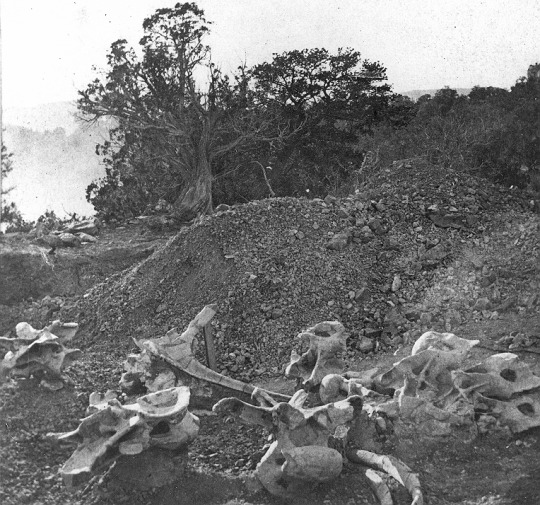
It is one of four large theropods in the Morrison Formation of the U.S. and the Lourina Formation of Portugal. There is currently only one accepted species: Ceratosaurus nasicornis.
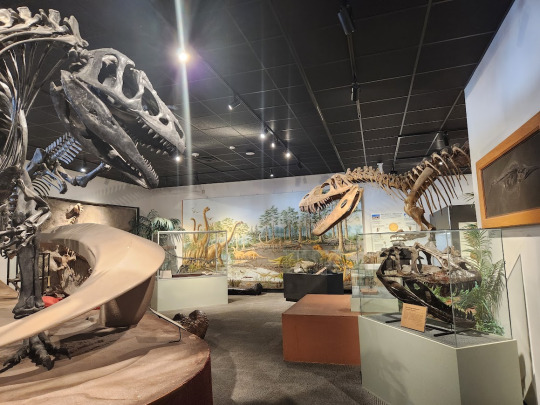
Allosaurus, Torvosaurus and Ceratosaurus at the BYU Museum of Paleontology.
Ceratosaurus is a medium-sized theropod. The type specimen is about 17 ft (5.3 m) long but other specimens indicate it could get more than 20 ft long. It is characterized by deep jaws that supported proportionally long, blade-like teeth, a prominent, ridge-like nasal crest, and a pair of crests over the eyes making it appear very dragon-like.

It had fairly short arms especially compared to its contemporary rivals. Each hand had four fingers with the three larger ones sporting a claw.

It also had a row of osteoderms that ran down it's neck, back and tail.
It is thought that Ceratosaurus was a solitary hunter. None have ever been found in close proximity to another. In a paper written by Donald M. Henderson in 1998, he stated that Ceratosaurus' taller skull indicated a resistance to bending. Its long, broad teeth would present increased frictional resistance to penetration due to increased surface area.

It had powerful adductor muscles that would increase the overall stresses on the entire skull. Having a deeper skull would relieve that by increasing the flexural rigidity and thus the strength. Think pit bull or hyena.

Ceratosaurus is only represented by a handful of specimens, far more common than Torvosaurus but still much less common than Allosaurus. There are two ideas floating around about why this is. One, there simply weren't as many of them. Two, it preferred a habitat that just didn't preserve fossils as well. Whatever the case may be, I hope that we can help answer some of these questions with the potential specimen we found at the Evil Tree Bonebed.

Possible Ceratosaur ischium (and it's a whopper for size).
Want to help recover the Ceratosaurus? Then come join us this summer at Colorado Northwestern Community College! Check out the link for more info. Hope to see you there!
66 notes
·
View notes
Text

Paleovember 2023, Maiasaura!
Living in Canada and Montana around 76 mya, Maiasaura is particularly famous for being the species that proved that dinosaurs (or at least hadrosaurs) looked after their young, hence the name 'mother lizard'. This is thanks to particularly rich bonebeds preserving nesting grounds with specimens of just about every age, giving us a strong look at the nesting habits and life cycle of the average Maiasaura.
#maiasaura#dinosaur#hadrosaur#ornithischians#paleoart#paleontology#prehistoric#illustration#art#artwork#cartoon#digitalart#drawing#procreate#late cretaceous#artist on tumblr
146 notes
·
View notes
Text
Kambara
Here I go again with croc stuff. Back to dealing with stuff thats longer established, let me tell you about Kambara, the oldest named mekosuchine and a genus that surprised me with the bulk of information behind it.
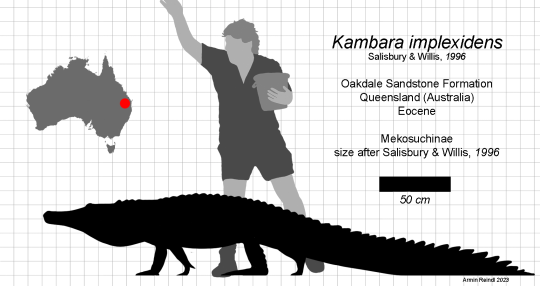
Kambara (which simply translates to "crocodile") is a genus of early mekosuchine that as of July 2023 contains four species, all from the Eocene of Queensland.
The first of these are Kambara murgonensis (Crocodile from Murgon) and Kambara implexidens (Interlocking Teeth Crocodile), both of which found at the same locality in Murgon, Queensland. The bones of both were in fact so intermingled that it was initially assumed that they represented a single species with highly variable anatomy, before the second species was recognized 3 years later.
There are a couple of differences between, but two are easiest to point out. For one, although being in the same size range (3-3.5 meters as adults), Kambara implexidens was a little more gracile. Furthermore, and the defining difference between them, K. implexidens (left) had interlocking teeth like a crocodile (bottom left), but K. murgonensis (right) had an overbite like an alligator (bottom right).

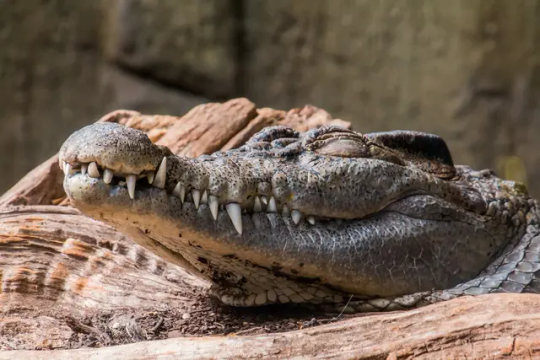

The next species named after these two was Kambara molnari (Molnar's Crocodile), but it's only known from much more limited material, the holotype being a lower jaw. Still some interesting information from this can be gathered. Which is that K. molnari seemingly represents an intermediate between interlocking dentition and an overbite. K. molnari wasn't found near Murgon, but in a different basin in Queensland, in the lower layers of the Rundle Formation.
Also from the Rundle Formation we have the most recently named and geologically youngest species, Kambara taraina (Crocodile Crocodile). Yeah the name is a bit redundant, but the logic of basing the species name on the Darumbal dialect as a proxy for language of the Bailai People is a nice one. Anyhow, K. taraina is a return to form as it is also known from good material like the first two, stemming from yet another large fossil bed possibly representing a mass death site. It had interlocking dentition like K. implexidens, BUT, unlike the oldest two species it did not coexist with the other Rundle Kambara. Instead, K. taraina came after K. molnari had presumably gone extinct.
Shown below the paratype of K. taraina, the holotype of K. implexidens and the holotype of K. molnari.

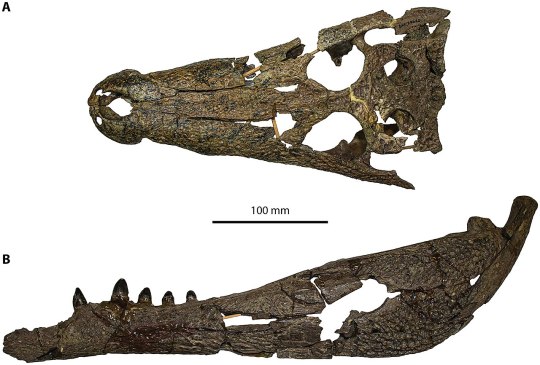
I won't get into phylogeny too much other than that its usually thought off as one of the earliest branching mekosuchines, but details vary. Lee and Yates found that Australosuchus may be more basal, while Ristevski et al. recover Kalthifrons as the earliest branch, in both cases Kambara is only the second branching.
There is one slightly odd alternative. Rio and Mannion do find it as the oldest branching mekosuchine....but also regard neither Quinkana nor Australosuchus as members of the clade...and further seemingly find "Asiatosuchus" germanicus to nest within Kambara? And then there's 2 out of the 8 trees by Ristevski, which show Kambara as a close relative to modern Crocodylids. But neither of those results match the current concensus and Rio and Mannion in general has a lot I disagree with.
Much more interesting is the postcrania and the implications for the lifestyle of Kambara. Now while we have a lot of bones from the rest of the body, given they were found in literal bonebeds, we don't know much about it. Crocodile fossils that aren't skulls are rarely described in detail. But there's still some information out there. Important here are Stein et al. 2012 and Buchanan's PhD thesis (which included the description of K. taraina, the one part that was formally published). Both looked at the postcrania and found that there are some differences to modern crocs. To keep things brief, while the anatomy is not nearly as derived as in a fully terrestrial croc, it does seem to suggest that Kambara would have had an easier time performing the crocodilian highwalk (shown below).
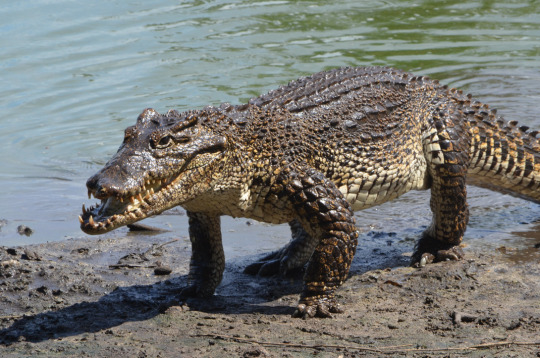
Again, this does not necessarily mean it lived on land, if anything the circumstances of the animals death seems to imply the opposite, but its still interesting. Buchanan suggests that this could have been used to walk through shallow water or bottom walking, and Stein et al. do point out that some adaptations of the limbs could also be advantages while swimming. The most important part to suggest that Kambara still lived in the water is the skull tho (well and it being found in freshwater habitats). The skull looks still remarkably like that of your generalist croc, somewhat flattened, nostrils on top, raised eyes, all that kind of stuff. So it presumably hunted like a modern croc and lived like a modern croc.
The exact lifestyle remains obscure tho. Again, generalist seems like the best supported hypothesis, but we don't know what kind of difference interlocking teeth and the overbite make. Theres some speculation of course. Mook for example proposed that an overbite functions like carnassial teeth in mammals, slicing and breaking, whereas interlocking dentition is better for gripping. While the difference in robustness between K. murgonensis and K. implexidens isn't that great, it could be suggested that the more robust species sliced and broke larger prey while the more gracile one dealt with slippery fish or struggling animals. Muscle attachments are also important, and those seem to show that the most recent species, Kambara taraina with interlocking teeth, had the greatest bite force and thus may have fed on larger prey than all its predecessors. But again, a lot of this requires further looking into.
We do have one singular piece of evidence for diet. The shell of a turtle from the Rundle Formation clearly bearing the tooth marks of Kambara. The bite marks show that the turtle was bitten multiple times, likely in an attempt to position it better in the mouth to bring it into position with the crushing back teeth or to swallow. Fun fact, this behavior is referred to as "juggling". But as you can see from the first figure, the Kambara in question was a bit cocky and picked a turtle way too large, eventually giving up. Sadly the turtle was very injured, and tho the wounds healed slightly, it eventually died from an infection.

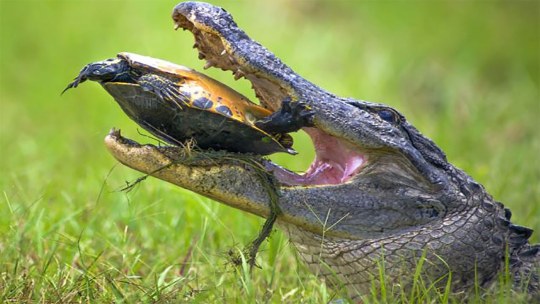
For the last section I briefly want to cover some last notes on Kambara murgonensis and Kambara implexidens, more specifically their coexistence. Now I covered the potential difference in hunting and prey preference already, but theres some other stuff to consider. For example, although found in the same locality, it is possible that this cohabitation was not the status quo. Given it is a mass death site at a locality that is known to have undergone wet and dry seasons, it is not unreasonable to assume that these animals died during a drought (another point against terrestrial life too, as they could have just left otherwise). Now even today crocs will gather in large groups in such situations, trying to make the most of dwindling water sources. This could mean that both species typically inhabited different biomes and only came together because they were forced to. The same might have also happend to Kambara taraina, causing increased aggression and explaining the many injured specimens found. Anyhow, it is also a possibility that they weren't divided by species, but by size, age and maturity. Buchanan points out that there are different habitat preferences between nesting females and juveniles, subadults and adult males in modern saltwater crocodiles. Big males prefer open water, nesting females areas with denser vegetation and subadults should avoid both as they threaten hatchlings and could be eaten by cannibalistic males. So that could also factor into the distribution of Kambara. And notably, it is pointed out that the Murgon site preserves both hachlings and egg shales, but seems to lack animals of intermediate size, which could suggest it was a nesting site.
Below a picture of an American Alligator and an American crocodile, simply because they remind me of Kambara and are an example of crocodilians that overlap in range, yet aren't super different like lets say Muggers and Gharials.
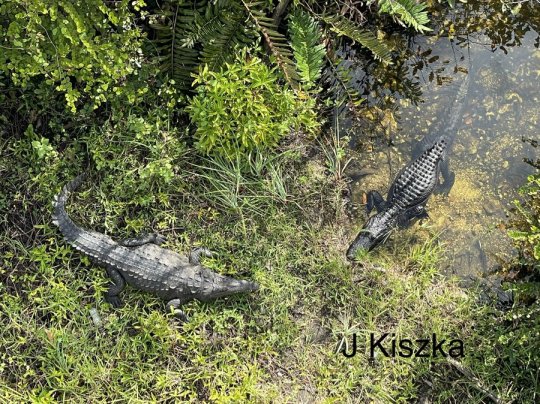
Alas Kambara suffers the mekosuchine curse, which is to say even with overwhelming material not much is actually published. Two bonebeds with all sorts of material, yet only 5 papers to its name, generally just accounting for the type description of each species + the humerus paper.
A lot of the info presented is actually from L.A. Buchanan's PhD thesis, which did include the description of Kambara taraina. However, since the completion of the thesis in 2008, only the description of the species was actually published. Entire chapters dealing with pathologies, postcrania and potential ecological inferrence are all are only present through the thesis, which has thankfully been uploaded in 2017.
Nevertheless, its a fascinating animal and I hope I made some people curious.
Wikipedia page:
Kambara - Wikipedia
#croc#crocodile#mekosuchinae#crocodilia#eocene#palaeoblr#prehistory#paleontology#long post#australia#skeletal#pseudosuchia#kambara#kambara implexidens#kambara murgonensis#kambara molnari#kambara taraina
75 notes
·
View notes
Note
I've been playing with the idea of part of WindClan territory being on a Pleistocene bonebed and someone finding a smilodon skull and thinking it was from one of their gods/a skull from a mountain settler. Maybe they think it's the skull of Shattered Ice because it was found near tunnels (their oral history traditions didn't preserve that he eventually joined RiverClan) It's unrealistic and would need a lot of geography fuckery, but it's a fun idea
Not actually as far fetched as you think, the only thing wrong here is the mention of a smilodon specifically. That's an American animal; you're more likely to find the Eurasian Cave Lion or a Scimitar Cat where I put BB.
Or even just, like, a normal European lion. England did very much have real lions that went extinct, and then the Romans brought MORE lions because they liked watching them fight.
Which is also a possibility by the way. The Romans were all up in this area, building walls and arenas and roads and other Roman things. The Roman Empire is ECOLOGICALLY VALID lmao
Like I'm deadass. They still have structures from Roman settlement. There's a funny story about William the Conqueror being super disappointed that this one Great Wall was less cool in person than his travel guide or whatever told him, and he got so mad he burnt the city down about it.
(Normal tourist reaction)
I want to throw some ruins into WindClan, too. So if not lions, then they probably could bump into human skeletons, or various bones of livestock. For some reason I want Breezepelt to find a skull and I don't even know why.
50 notes
·
View notes
Text
It Came From The Trash Heap (We Don't Talk About Kholumolumo)
A wastebasket taxon is what happens when species can't be easily classified and instead get hurled into a "catch-all" category.
…But that's not the only kind of taxonomic tangle that can befall a new discovery.
When a scientific name is assigned to a new species, but it isn't given a corresponding formal description and type specimen, it becomes a nomen nudum – a "naked name". Without a proper description and assigned holotype the name isn't valid, and the new species isn't technically accepted by the wider scientific community.
This has even happened to some surprisingly famous names. In the 1920s Velociraptor mongoliensis was briefly given the nomen nudum "Ovoraptor djadochtari" before getting its much more familiar name when it was officially described. Meanwhile the giant pterosaur Quetzalcoatlus northropi was stuck as a nomen nudum for decades, only finally getting a proper published description in 2021.
And there's another particular long-standing nomen nudum that became mildly infamous – "Thotobolosaurus", the "trash heap lizard".
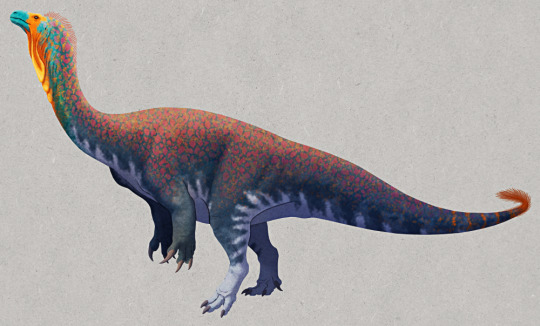
Discovered next to a literal trash pile in the village of Maphutseng in Lesotho, a few scattered and broken bones of this "prosauropod" sauropodomorph dinosaur were first found in 1930. But it wasn't until the mid-1950s that a more extensive bonebed began to be unearthed at the site, and over the next decade over 1000 fossil fragments were collected.
In the mid-1960s the remains were initially classified as belonging to Euskelosaurus browni (which is now considered to be a wastebasket taxon), but just a few years later in 1970 the "Maphutseng Beast" was re-evaluated as a species new to science. It was referred to as "Thotobolosaurus mabeatae" – based on the local name of the discovery site, "Thotobolo ea ‘Ma-Beata" (trash heap of Beata’s mother) – but this name was never actually formally published.
Despite "Thotobolosaurus" being an undescribed nomen nudum it nonetheless went on to be repeatedly referenced in scientific literature over the next few decades, and appeared in several popular dinosaur books (even as recently as 2020!).
In the mid-1990s it was alternatively named "Kholumolumosaurus ellenbergerorum" in a Ph.D. dissertation, with this name derived from the kholumolumo, a reptilian creature in Sotho mythology, and the Ellenberger brothers who worked on the site. But this also didn't count as a formal publication and instead became a second nomen nudum for the species.
Eventually, 90 years after the first bones were found and 50 years after the debut of the name "Thotobolosaurus", this long-neglected sauropodomorph was finally given a proper published full anatomical description in 2020.
And it also got a third name, this time officially valid, based on the second one from the 1990s: Kholumolumo ellenbergerorum.
For something associated with trash for so long, Kholumolumo is actually now one of the most completely-known prosauropods. At least five different individuals were present in the collected fossil material, possibly as many as ten, and between them most of the full skeleton is represented – with the exception of the skulls, which are only known from a couple of small fragments.
We now know Kholumolumo was rather heavily-built, with chunky limb bones and unusually short shinbones. It would have been one of the biggest animals around in the Late Triassic (~210 million years ago), measuring at least 9m long (~30') and weighing around 1.7 tonnes (1.9 US tons), but despite its size it seems to have still been bipedal.
Due to the highly disarticulated nature of the bones the fossil site may have been a "bone accumulation area", a place where dismembered bits and pieces of different carcasses were regularly carried to be eaten by a predator or scavenger – essentially a trash heap, fittingly enough. A couple of "rauisuchian" teeth have actually been found among the remains, which might indicate what was chomping on these particular Kholumolumo.
———
Nix Illustration | Tumblr | Twitter | Patreon
#it came from the wastebasket#nomen nudum#taxonomy#kholumolumo#thotobolosaurus#prosauropod#massopoda#sauropodomorpha#dinosaur#paleontology#art#science illustration#paleoart#palaeoblr
290 notes
·
View notes
Text

Avimimus nemegtensis, meaning “bird mimic”, was a very birdy oviraptorosaur and the type species of its own family Avimimidae, though some paleontologists put it within Caenognathidae. It had a long neck with a small head, though its braincase and eyes were comparatively large. Its legs were long and slender, and it was likely a fast runner. There are at least two species of Avimimus, A. portentosus (described in 1981) and A. nemegtensis (described in 2018 and depicted here). The tail was missing on the original Avimimus portentosus fossil, leading its describer to conclude that it must have lacked a tail in life! However, later specimens with caudal vertebrae and hips designed for carrying a long tail suggested otherwise. Due to its small to nonexistent teeth, it’s likely Avimimus was a herbivore and/or insectivore. Avimimus nemegtensis specimens have been found in a bonebed containing at least 10 individual adults, suggesting they may have flocked together or at least formed leks.


Once thought to have come from the Djadochta Formation, it is now considered more likely that both Avimimus species lived in the more recent Nemegt Formation. While currently in the middle of the Gobi Desert, the Nemegt Formation of Late Cretaceous Mongolia was once more lush and green, with forests of tall conifer trees, streams, and shallow lakes covered in duckweed and pondweed. Rivers carved out steep cliffs and canyons. This habitat supported a diverse amount of fauna, and Avimimus nemegtensis would have lived alongside a variety of dinosaurs, including true birds. While it was seemingly the only avimimid here (aside from A. portentosus), it lived alongside both oviraptorids like Nemegtomaia and caenognathids like Elmisaurus. Another “bird-mimic”, the speedy ornithomimosaur Gallimimus lived in the Nemegt as well. It would seem speed was necessary for these animals, as the tyrannosaur Tarbosaurus would have been the apex predator. If it could catch it, Avimimus would have been an easier meal for Tarbosaurus than the giant-clawed Therizinosaurus, the hadrosaurs Barsboldia and Saurolophus angustirostris, and the titanosaur Nemegtosaurus. But there was still a wealth of smaller prey Tarbosauruses both young and old could have pursued, such as the little pachycephalosaurs Homalocephale and Prenocephale, the troodontid Tochisaurus, and even the smaller tyrannosauroid Bagaraatan. Avimimus would have had to use its quick wits and quicker legs to stay alive.


This art may be used for educational purposes, with credit, but please contact me first for permission before using my art. I would like to know where and how it is being used. If you don’t have something to add that was not already addressed in this caption, please do not repost this art. Thank you!
#Avimimus nemegtensis#Avimimus#avimimid#oviraptorosaurs#theropods#saurishcians#dinosaurs#archosaurs#archosauromorphs#reptiles#Nemegt Formation#Late Cretaceous#Mongolia
9 notes
·
View notes
Text

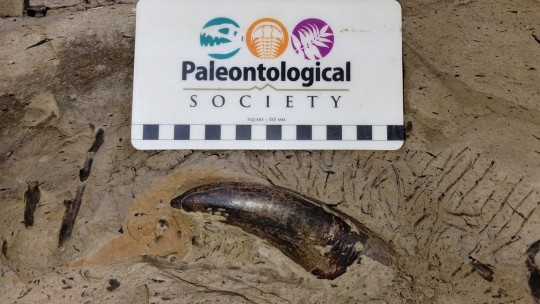




Bighorn Bonebed near Hinsdale, MT, 2023 field season. This site preserves multiple Brachylophosaurus sp. who died in a group.
#palaeontology#paleontology#paleoblr#palaeoblr#fossils#fossil#dinosaurs#bighorn Bonebed#fieldwork#photography#Hinsdale#animals#fieldwork 2023
131 notes
·
View notes
Note
OPINION ON ARCHEN AND ARCHEOPS.
-@stxr-skxllz
I love them!!!
Cute little protobirds!!!!!!!
The size of Archeops can be a little... concerning though. Especially because they hunt in packs.
1 note
·
View note
Text
A recent study from the University of Hammerlocke has shown that the Zigzagoon population from Hoenn have the potential to evolve further from Linoone.
Galarian Linoone can evolve into Obstagoon, while Hoennian Linoone do not evolve at all. The researchers hypothesize that they did evolve further in the distant past, but simply do not anymore.
Fossil evidence found in a bonebed near Slateport City show a very large mammalian predator that dug expansive burrows which are quite similar to those of modern Zigzagoon!
21 notes
·
View notes
Note
Hiding behind the facade of a man will not make you any less a woman. It won’t heal you of your pain.
There’s nothing wrong with your body. Please stop hating yourself.
Oh boy, there's TONS of stuff wrong with my body. I've got asthma, allergies, the one bad eye, acid reflux like nobody's business (famotidine is good for it, I gotta say), intermittent costochondritis, hypothyroid, at least two enzymatic conditions, and I haven't been to a podiatrist in years so my Achilles' tendonitis is kinda out of control, my left leg is getting to the point where it's weaker than the right, I need a doc on that. Oh, and the BPPV, but that's a nuisance more than anything.
I assume you don't know any of this, because I assume you don't know me, or you would know that I don't have any interest in going out of my way to present masculine, so I can't "hurt my body" with it. I did have a full hysterectomy about a decade back, because from puberty my periods were very heavy, very long, very painful, and pulled the rug out on my OCD/anxiety/depression meds, leaving me incapacitated and weak. After a diagnosis of PMDD with probable endometriosis, long before I identified as trans, I lobbied to have the operation done for quality of life, and when I finally did--I can't begin to describe how much better I am now. I really, honestly can't, you would have to see me in my old bleeding-out days. I'm on estrogen to avoid early menopause, calcium for my bonebs. Following in my cis aunt's footsteps, actually, my maternal line has a lot of jank uterine DNA, and Mom used to talk about how Aunt M was lying in bed after *her* hysterectomy and going "I feel so much better, I feel so much better", and the ensuing health uptick after that. So, like, not gender related, people do get confused about that. No interest in surgeries w/r/t presentation.
That covers the physical section pretty well...uh, like I said, have the anxiety triad, but it's been covered for years as long as I get my meds on time, and I'm strong enough now to make the phone calls to make that happen. That's big for me, I really did have a lot of pain after my mom died, but in the years since, I feel like I've worked through what can be worked through in grief. It still crops up, but it's not paralytic. Same with the agoraphobia, I keep working on it and it keeps getting better. I'm volunteering once a week now, and I know that's small potatoes for most people, but with my energy issues, I'm proud of myself. I'm not sure how I feel about the prospect of having a job again in this market, just because I've been off the horse so long, but I'm certainly putting feelers out there, could use extra funds for when I go see my fiance.
So, I dunno, Doc...what was your name again? You are a doctor, right? Like, my doctor? Because I'm confused why anyone else would need to know this, and, now that I think about it, I'm a little confused because I don't recall hiring anyone for a check-up, but I'm doing okay. You do read the status forms I give you at med checks, right? I know there was an anxiety bump when I started volunteering, and not gonna lie, it's stressful, but I feel a lot more alive for it. More work, more walk, less weed, like we talked about.
Gosh, it really feels nice to talk things out with you. So, schedule out for three months, see what's happening then? I'm inevitably gonna postpone once because I forgot it was due and then potentially come in five minutes late because of that *ungodly* bus stop, but the important thing is we both know that. See you then, thanks so much!
#Med check#About me#Anon#That's my fifteen minutes God knows I'm not on the fancy health insurance#Del is a trans guy#But is not a wistful 17-year-old lady fancier with HRT and top surgery and whatever else you need to be on the Trans Bingo Board#Sorry to disappoint
5 notes
·
View notes
Text


Happy Fossil Friday!
Who: Albertosaurus sarcophagus ("Alberta-Lizard" "flesh-eater")
What: A large tyrannosaur from the Theropoda clade.
When: Late Cretaceous
Where: Horseshoe Canyon Formation in Alberta, Canada
Fun Fact!: Albertosaurus was first discovered on the Red Deer River in Drumheller, Alberta in 1884 by geologist Joseph Tyrrell, for whom the world famous museum in Drumheller is named. Tyrrell's specimen remained unnamed until 1905 until the discovery of Tyrannosaurs rex in Colorado. This coincided with the province of Alberta being founded on September 1st in 1905 and Albertosaurus shares its namesake.
Why are they cool?: Evidence suggests that these large, predatory dinosaurs lived together in family groups and hunted in packs, rather than in solitary. The same may be true for other theropods.
Here is a link to a paper discussing the ages and assemblage of the Dry Island Bonebed in Drumheller, where a whopping 26 Albertosaurus were discovered!
Image Credits: (Left and Right) www.thoughtco.com - fun fact! both these images were taken at the Royal Tyrrell Museum in Drumheller Alberta.
#palaeontology#paleontology#fossil friday#fossils#paleo#albertosaurus#albertosaurus sarcophagus#alberta#royal tyrrell museum#drumheller#tyrannosaur#horseshoe canyon
8 notes
·
View notes
Text
Let's Talk About BENTONITE
There's nothing worse than minding your own business, walking along in the desert when all of a sudden your feet start to feel weighted down. It gets harder and harder to pick up your feet. The mud is sticky and pulling you into the ground. That's bentonite.

Bentonite is type of very soft, plastic clay made primarily of montmorillonite clay.
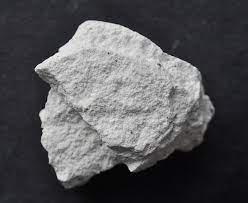
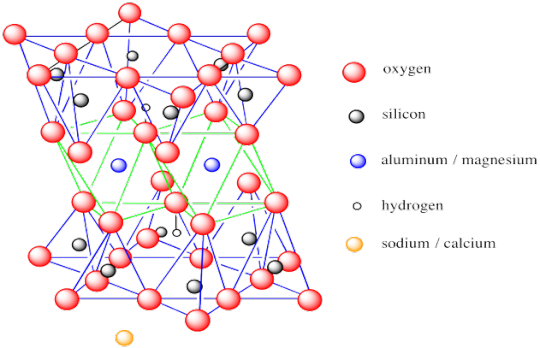
Montmorillonite is a hydrous, aluminum silicate in the smectite group (often you will hear bentonite and smectite used interchangeably).
Bentonite is formed by the alteration of volcanic ash when it comes in contact with water. Clays in general form from the chemical breakdown of feldspars (check out October's posts for more on feldspar!) and when ash gets thrown in the mix something very nasty occurs: swelling clays.
Bentonite increases greatly in volume when water is added...and decreases just as much when the water evaporates or gets absorbed in the groundwater system. This causes the popcorn texture you see in badlands topography.

Popcorn texture in Brushy Basin Member, Morrison Formation, near Evil Tree Bonebed. Sauropod rib found in it.
This can also cause structural damage. That is why the building around the Wall at Dinosaur National Monument had to be repaired a few years ago. Basically, the swelling of the bentonite split the foundation.
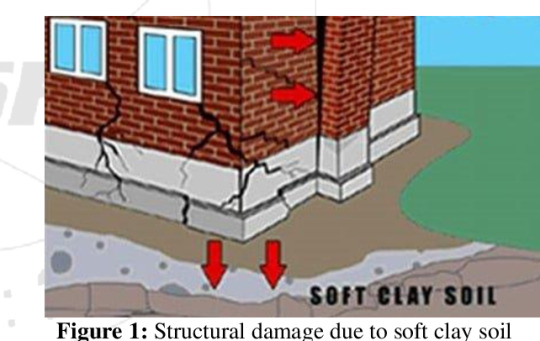
It also becomes very dangerous to drive on or walk on when it gets wet, becoming a slurry, sticky mess.
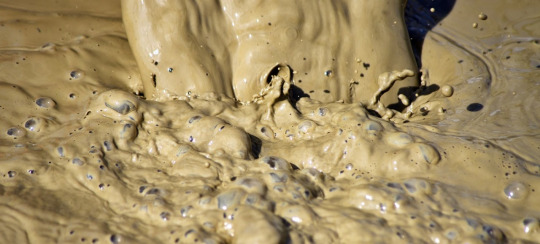
This is the main reason why we have to wait for summer to come before we head out to the dig site. We physically cannot get there until the Mancos Shale bentonite is dry enough to drive on.
Bentonite is not all bad though. It has some good uses too.

We actually use it to trap moisture in our skin and hair when we dry out. It's a natural sunblock and relieves burns and itching from bug bites. We even put it in Wendy's Frosty's to give them that smooth texture!

Bentonite is also used in agriculture as a natural pesticide, herbicide, and fungicide in fertilizers.
They also use it to coat drills in the oil industry to keep the drill bit lubricated, as well as coating well walls to keep them from collapsing. If you're a geek, like me, think Avatar, the Last Air Bender and the Fire Nation drill.

Hope you learned a little about bentonite today! Fossilize you later!
63 notes
·
View notes